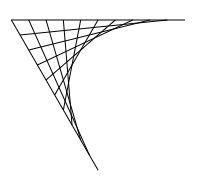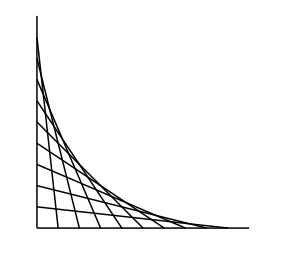Graphics Render Examples
Jump to navigation
Jump to search
Graphics Render Examples
Line and Triangle Examples
pointcoords=POLYPOINTS(3,100,100); s=LINESPLIT(pointcoords,10,true) lines1=(s[0].rowpush(s[1])).m(r=>r.flatten()) lines2=(s[1].rowpush(s[2])).m(r=>r.flatten()) lines3=(s[2].rowpush(s[0])).m(r=>r.flatten()) var d= [ ["type","coordinates","count"], ["line",lines1,lines1.length], ] RENDER(d) ""
pointcoords=POLYPOINTS(4,100,100); s=LINESPLIT(pointcoords,10,true) lines1=(s[0].rowpush(s[1])).m(r=>r.flatten()) lines2=(s[1].rowpush(s[2])).m(r=>r.flatten()) lines3=(s[2].rowpush(s[3])).m(r=>r.flatten()) lines4=(s[3].rowpush(s[0])).m(r=>r.flatten()) var d= [ ["type","coordinates","count"], ["line",lines1,lines1.length] ] RENDER(d) ""
pointcoords=POLYPOINTS(4,100,100); s=LINESPLIT(pointcoords,10,true) lines1=(s[0].rowpush(s[1])).m(r=>r.flatten()) lines2=(s[1].rowpush(s[2])).m(r=>r.flatten()) lines3=(s[2].rowpush(s[3])).m(r=>r.flatten()) lines4=(s[3].rowpush(s[0])).m(r=>r.flatten()) var d= [ ["type","coordinates","count"], ["line",lines1,lines1.length], ["line",lines2,lines2.length], ] RENDER(d) ""
pointcoords=POLYPOINTS(4,100,100); s=LINESPLIT(pointcoords,10,true) lines1=(s[0].rowpush(s[1])).m(r=>r.flatten()) lines2=(s[1].rowpush(s[2])).m(r=>r.flatten()) lines3=(s[2].rowpush(s[3])).m(r=>r.flatten()) lines4=(s[3].rowpush(s[0])).m(r=>r.flatten()) var d= [ ["type","coordinates","count"], ["line",lines1,lines1.length], ["line",lines2,lines2.length], ["line",lines3,lines3.length], ["line",lines4,lines4.length] ] RENDER(d) ""
pointcoords=POLYPOINTS(4,100,100); s=LINESPLIT(pointcoords,10,true) lines1=(s[0].rowpush(s[1])).m(r=>r.flatten()) lines2=(s[1].rowpush(s[2])).m(r=>r.flatten()) lines3=(s[2].rowpush(s[3])).m(r=>r.flatten()) lines4=(s[3].rowpush(s[0])).m(r=>r.flatten()) lines5=(s[2].rowpush(s[0])).m(r=>r.flatten()) lines6=(s[1].rowpush(s[3])).m(r=>r.flatten()) var d= [ ["type","coordinates","count"], ["line",lines1,lines1.length], ["line",lines2,lines2.length], ["line",lines3,lines3.length], ["line",lines4,lines4.length], ["line",lines5,lines5.length], ["line",lines6,lines6.length] ] RENDER(d) ""
Cardioid Examples
Following the "the midpoints of the circles lie on the perimeter of the fixed generator circle" method to draw a cardioid:
1) Choose a circle c and a point p on its perimeter, 2) Draw circles containing point p with centers on the perimeter of circle c
Example 1
numpoints=50; pts=MAKEPOLYGONPOINTS(numpoints,[50,50],[200,200], 270) start=pts[0]; circlesat= pts .map( p=>[p[0],p[1],SQRT(POWER(p[0]-start[0],2)+POWER(p[1]-start[1],2))] ) RENDER( [ ["type","cx","cy","r","stroke","stroke-width","count"], ["circle",circlesat.column(0),circlesat.column(1),circlesat.column(2),"red",1,circlesat.length] ] ) ""
Example 2
numpoints=50; pts=MAKEPOLYGONPOINTS(numpoints,[30,50],[200,200], 150) start=pts[0]; circlesat1= pts .map( p=>[p[0],p[1],SQRT(POWER(p[0]-start[0],2)+POWER(p[1]-start[1],2))] ) pts=MAKEPOLYGONPOINTS(numpoints,[70,70],[500,200], 0) start=pts[0]; circlesat2= pts .map( p=>[p[0],p[1],SQRT(POWER(p[0]-start[0],2)+POWER(p[1]-start[1],2))] ) cycloids = RENDER( [ ["id","type","cx","cy","r","stroke","stroke-width","count"], ["cycloid1","circle",circlesat1.column(1),circlesat1.column(0),circlesat1.column(2),"red",1,circlesat1.length], ["cycloid2","circle",circlesat2.column(1),circlesat2.column(0),circlesat2.column(2),"red",1,circlesat2.length] ] ) ; RENDER( [ ["id" , "animate","animationsettings"], ["cycloid1" , "animate",[["loop","rotate","duration","easing"],[true,-360,5*1000,"linear"]]] , ["cycloid2" , "animate",[["loop","rotate","duration","easing"],[true,360,5*1000,"linear"]]] ] , cycloids ) ""






